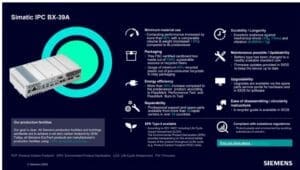 Aside from creating products that have sustainable benefits, Siemens has increased the value of their offerings by focusing on the traceability and data verification of their products. Companies across the globe are being placed under pressure to keep an accurate record of emissions data across their entire supply chain, due to regulations requiring annual reporting.
Aside from creating products that have sustainable benefits, Siemens has increased the value of their offerings by focusing on the traceability and data verification of their products. Companies across the globe are being placed under pressure to keep an accurate record of emissions data across their entire supply chain, due to regulations requiring annual reporting.
Siemens has 100,000 or even millions of products, and they hope to reduce the environmental impact of these products. They are working on combining the real and the digital world as they believe digitalization is a key enabler for sustainability. They see three key impact pillars to achieving sustainability, and they are: decarbonization & energy efficiency, resource efficiency & circularity, and people centricity & societal impact.
Siemens has existed and operated within the decarbonization and energy efficiency pillar but with this new product they are taking account of societal impact. Rethinking how products can provide a sustainable impact but also considering the technological impacts on the environment from its associated production operations, as well as its supply chain. The aim is to transform the whole value chain to reduce the environmental footprint of a product. The key is to reduce inputs, increase circularity, and reduce waste. This transformation process will not be free and will cost more during this transition period. To assist communicating about the benefits of these products, the EcoTech label was created.
The EcoTech label is all about reducing the environmental footprint of products while scaling sustainability impact. The label is granted to Siemens products to highlight and show that they are outperforming the sustainability achievements and capabilities. Each product that receives this label must either have an EPD label type two, or in more rare cases an EPD type three. The information in the EPD must be displayed transparently, showing the product’s relevant performance data, which is available via a QR code.
It is a mandatory requirement for each Siemens EcoTech product to have this, and it is also mandatory that they’re compliant with substance regulations as well as made in production facilities electrified with a hundred percent renewable electricity. In addition to this, it also needs to fulfill one criteria in each of our three dimensions. These three dimensions represent the total products lifecycle management, including the materials required to create the product, efficient use of the product, and its end of life.
The label itself can be found on the product, EcoTech label webpage, and the relevant sales touchpoint. The label visual is only present alongside the Siemens EcoTech profile; you cannot have one without the other. The profile is a two-page document that includes the sustainability achievements and capabilities of the product, which allows total transparency to the customers.
Think of the EcoTech profile as a background check. It provides customers with auditable data, sustainable achievement metrics, such as energy efficiency, and useful information that can be used for product comparison. This profile can be a useful resource for companies who are searching for products that will support their organization’s decarbonization targets.




















